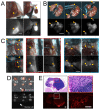Image-guided drug delivery of nanotheranostics for targeted lung cancer therapy
- PMID: 35673583
- PMCID: PMC9169367
- DOI: 10.7150/thno.72803
Image-guided drug delivery of nanotheranostics for targeted lung cancer therapy
Abstract
Enormous efforts have been made to integrate various therapeutic interventions into multifunctional nanoplatforms, resulting in the advance of nanomedicine. Image-guided drug delivery plays a pivotal role in this field by providing specific targeting as well as image navigation for disease prognosis. Methods: We demonstrate image-guided surgery and drug delivery for the treatment of lung cancer using nanotheranostic H-dots loaded with gefitinib and genistein. Results: The surgical margin for lung tumors is determined by image guidance for precise tumor resection, while targeted anti-cancer drugs function simultaneously for synergistic combination therapy. Compared to conventional chemotherapies, H-dot complexes could improve the therapeutic efficacy of drugs while reducing the risk of adverse effects and drug resistance owing to their ideal biodistribution profiles, high targetability, low nonspecific tissue uptake, and fast renal excretion. Conclusions: These H-dot complexes have unlocked a unique framework for integrating multiple therapeutic and diagnostic modalities into one nanoplatform.
Keywords: Cancer therapy; Combination therapy; Image-guided surgery; Renal clearance; Theranostics.
© The author(s).
Conflict of interest statement
Competing Interests: The authors have declared that no competing interest exists.
Figures








Similar articles
-
Renal Clearable Theranostic Nanoplatforms for Gastrointestinal Stromal Tumors.Adv Mater. 2020 Feb;32(6):e1905899. doi: 10.1002/adma.201905899. Epub 2019 Dec 18. Adv Mater. 2020. PMID: 31854033 Free PMC article.
-
Recent advances of polymeric nanoplatforms for cancer treatment: smart delivery systems (SDS), nanotheranostics and multidrug resistance (MDR) inhibition.Biomed Mater. 2023 Nov 27;19(1). doi: 10.1088/1748-605X/ad0b23. Biomed Mater. 2023. PMID: 37944188 Review.
-
Tumor Penetrating Theranostic Nanoparticles for Enhancement of Targeted and Image-guided Drug Delivery into Peritoneal Tumors following Intraperitoneal Delivery.Theranostics. 2017 Apr 10;7(6):1689-1704. doi: 10.7150/thno.18125. eCollection 2017. Theranostics. 2017. PMID: 28529645 Free PMC article.
-
Using Peptide Aptamer Targeted Polymers as a Model Nanomedicine for Investigating Drug Distribution in Cancer Nanotheranostics.Mol Pharm. 2017 Oct 2;14(10):3539-3549. doi: 10.1021/acs.molpharmaceut.7b00560. Epub 2017 Sep 7. Mol Pharm. 2017. PMID: 28880092
-
Theranostics of metal-organic frameworks: image-guided nanomedicine for clinical translation.Nanomedicine (Lond). 2023 Apr;18(8):695-703. doi: 10.2217/nnm-2022-0278. Epub 2023 Jun 1. Nanomedicine (Lond). 2023. PMID: 37259854 Review.
Cited by
-
Gold Nanoparticle Transport in the Injured Kidneys with Elevated Renal Function Biomarkers.Adv Mater. 2024 Sep;36(36):e2402479. doi: 10.1002/adma.202402479. Epub 2024 Jul 29. Adv Mater. 2024. PMID: 39073056
-
Renal Clearable H-Dots Leveraging Ligand Complexation for Enhanced Active Tumor Targeting.Small Sci. 2024 Aug 13;4(11):2400246. doi: 10.1002/smsc.202400246. eCollection 2024 Nov. Small Sci. 2024. PMID: 40213466 Free PMC article.
-
H-Dot Mediated Nanotherapeutics Mitigate Systemic Toxicity of Platinum-Based Anticancer Drugs.Int J Mol Sci. 2023 Oct 23;24(20):15466. doi: 10.3390/ijms242015466. Int J Mol Sci. 2023. PMID: 37895146 Free PMC article.
-
Lipocalin-2 promotes NSCLC progression by activating the JAK2/STAT3 signaling pathway.J Transl Med. 2025 Apr 10;23(1):419. doi: 10.1186/s12967-025-06418-1. J Transl Med. 2025. PMID: 40211270 Free PMC article.
-
New strategies for lung cancer diagnosis and treatment: applications and advances in nanotechnology.Biomark Res. 2024 Nov 13;12(1):136. doi: 10.1186/s40364-024-00686-7. Biomark Res. 2024. PMID: 39533445 Free PMC article. Review.
References
-
- Edwards BK, Noone AM, Mariotto AB, Simard EP, Boscoe FP, Henley SJ. et al. Annual Report to the Nation on the status of cancer, 1975-2010, featuring prevalence of comorbidity and impact on survival among persons with lung, colorectal, breast, or prostate cancer. Cancer. 2014;120:1290–314. - PMC - PubMed
-
- Arbour KC, Riely GJ. Systemic therapy for locally advanced and metastatic non-small cell lung cancer: a review. JAMA. 2019;322:764–74. - PubMed
-
- Siegel RL, Miller KD, Jemal A. Cancer statistics, 2019. CA Cancer J Clin. 2019;69:7–34. - PubMed
Publication types
MeSH terms
Substances
Grants and funding
LinkOut - more resources
Full Text Sources
Medical

